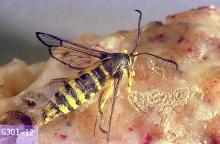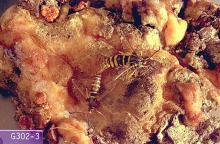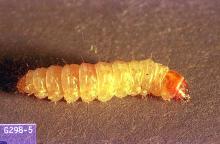Synanthedon sequoiae
Pest description and damage The adult is a clearwing moth about 1.0 to 1.25 inches in length with yellow and black markings resembling yellowjacket wasps. The larvae are about 1 inch long, yellowish, with a reddish-brown head. Larvae feed by boring into branches or trunks. At the point where the larva enters the wood, small to large masses of creamy yellow to pinkish pitch accumulate. The larva feeds locally underneath the pitch mass. This pest causes mainly aesthetic damage because of the pitch masses. They do not attack sequoia (aka the coast redwood).
Biology and life history Eggs are laid on the bark of host trees. The larvae bore into the inner bark and establish a feeding site. The feeding site are distinguished easily by the large accumulation of pitch and frass on the exterior of the bark. Pupation takes place within this mass, and the adult moths fly through the summer months. About half the population completes its life cycle in one year; the other half requires two years.
Pest monitoring Periodically check pitch masses for the partially emerged pupa case. If the moth has emerged, the pupal case will be papery and empty. Pheromone traps are available to time adult activity and physically remove males.
Management-cultural control
Healthy trees are not commonly attacked. Infestations often are associated with pruning wounds or mechanical damage to the tree. Trees pruned or wounded in the spring and summer when adult moths are flying are far more likely to be attacked than those trees pruned or injured in the fall and winter. The moths are attracted to trees undergoing stresses associated with drought or saturated soil. Remove pitch masses by hand or dig out larvae with a knife.
Management-chemical control
See Table 4 in:




